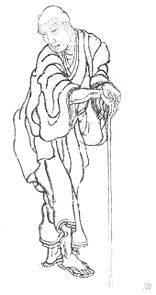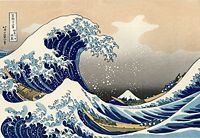Hokusai
2008/9 Schools Wikipedia Selection. Related subjects: Artists
| Hokusai | |
 Katsushika Hokusai |
|
| Birth name | Tokitarō |
| Born | October - November 1760 Edo, now Tokyo, Japan |
| Died | May 10, 1849 Tokyo |
| Nationality | Japanese |
| Field | Painting and Printing |
Katsushika Hokusai, (葛飾北斎), (1760—1849), was a Japanese artist, ukiyo-e painter and printmaker of the Edo period . In his time he was Japan's leading expert on Chinese painting. Born in Edo (now Tokyo), Hokusai is best-known as author of the woodblock print series Thirty-six Views of Mount Fuji, (c. 1831), which includes the iconic and internationally-recognized print, The Great Wave off Kanagawa (created during the 1820s). Hokusai created the "Thirty-Six Views" both as a response to a domestic travel boom and as part of a personal obsession with Mount Fuji. It was this series, specifically The Great Wave print and Fuji in Clear Weather, that secured Hokusai’s fame both within Japan and overseas. As historian Richard Lane concludes, “Indeed, if there is one work that made Hokusai's name, both in Japan and abroad, it must be this monumental print-series...” . While Hokusai's work prior to this series is certainly important, it was not until this series that he gained broad recognition and left a lasting impact on the art world. Indeed, it was The Great Wave print that initially received, and continues to receive, acclaim and popularity in the Western world. Hokusai is considered one of the outstanding figures of Japanese woodblock printing, sometimes referred to as ukiyo-e.
Biography
Born on Oct. 1760, Edo, Japan and died May 10, 1849, Hokusai was an Edo Japanese painter, draftsman, printmaker, and book illustrator. Hokusai, whose childhood name was Tokitarō, was born in Edo (now Tokyo) on the 23rd day of 9th month of the 10th year of the Hōreki period (October – November 1760) to an artisan family. It is believed his father was the mirror-maker Nakajima Ise, who produced mirrors for the shogunate. At the age of 14, he became an apprentice to a wood-carver, where he worked until the age of 18, whereupon he entered the studio of Katsukawa Shunshō, a ukikyo-e artist and head of the so-called Katsukawa School.
Hokusai's name changes are so frequent, and related to changes in his artistic production, that they are useful for breaking his life up into periods.
Hokusai spent a total of 19 years in the Katsukawa School. Rumor suggests he was expelled from the school (possibly due to studies at the rival Kanō school); regardless, in 1795, Hokusai changed his nom d'artiste to Shunrō. This period was, in his own words, inspirational: "What really motivated the development of my artistic style was the embarrassment I suffered at Shunkō's hands." Shunkō was the senior disciple of Shunshō. "Fireworks at Ryōgoku Bridge" (1790) dates from this period of Hokusai's life.
The next period saw Hokusai's association with the Tawaraya School and the adoption of the name Tawaraya Sōri. He produced many brush paintings, surimono, and illustrations for kyōka ehon during this time. In 1798, Hokusai passed his name on to a pupil and set out as an independent artist (free from ties to a school) for the first time, adopting the name Hokusai Tomisa. This name lasted until 1811, when, at the age of 51, Hokusai changed his name to Taito and entered the period in which he created the Hokusai Manga and various etehon, or art manuals.
In 1820, Hokusai changed his name yet again, this time to Iitsu, a change which marked the start of a period in which he secured fame as an artist throughout Japan (though, given Japan's isolation from the outside world during his lifetime, his fame overseas came after his death). It was during this time that Hokusai created the most well-recognized of his works, Thirty Six Views of Mount Fuji. A Tour of the Waterfalls of the Provinces and Unusual Views of Celebrated Bridges in the Provinces are other landscape series dating from this period.
The next period, beginning in 1834, saw Hokusai working under the name Gakyō Rōjin Manji (The Old Man Mad About Art). It was at this time that Hokusai produced " One Hundred Views of Mount Fuji," another significant landscape series.
In the postscript to this work, Hokusai writes:
| “ | From around the age of six, I had the habit of sketching from life. I became an artist, and from fifty on began producing works that won some reputation, but nothing I did before the age of seventy was worthy of attention. At seventy-three, I began to grasp the structures of birds and beasts, insects and fish, and of the way plants grow. If I go on trying, I will surely understand them still better by the time I am eighty-six, so that by ninety I will have penetrated to their essential nature. At one hundred, I may well have a positively divine understanding of them, while at one hundred and thirty, forty, or more I will have reached the stage where every dot and every stroke I paint will be alive. May Heaven, that grants long life, give me the chance to prove that this is no lie. | ” |
Constantly seeking to produce better work, he apparently exclaimed on his deathbed, "If only Heaven will give me just another ten years ... Just another five more years, then I could become a real painter." He died on April 18th 1849 and was buried at the Seikyōji temple in Tokyo (Taito Ward).
Works and Influences
Hokusai had a long career, but he produced most of his important work after age 60. His most popular work is ukiyo-e series Thirty-six Views of Mount Fuji (富嶽三十六景 Fugaku Sanjūrokkei), which was created between 1826 and 1833. It actually consists of 46 prints (10 of them added after publication). In addition, he is responsible for the 1834 One Hundred Views of Mount Fuji (富嶽百景 Fugaku Hyakkei), a work which "is generally considered the masterpiece among his landscape picture books."
The largest of Hokusai's works is the 15 volume collection Hokusai Manga (北斎漫画), a book crammed with nearly 4,000 sketches that was published in 1814. These sketches are often incorrectly considered the precedent to modern manga, as Hokusai's Manga is a collection of sketches (of animals, people, objects, etc.), different from the story-based comic-book style of modern manga.
Both Hokusai’s choice of nom d'artiste and frequent depiction of Mt. Fuji stem from his religious beliefs. The name Hokusai means "North Studio (room)," (北斎) an abbreviation of Hokushinsai (北辰際) or "North Star Studio." Hokusai was a member of the Nichiren(日蓮)sect of Buddhism. For Nichiren followers, the North Star is associated with the deity Myōken(妙見菩薩).
Mount Fuji has traditionally been linked with eternal life. This belief can be traced to the The Tale of the Bamboo Cutter, where a goddess deposits the elixir of life on the peak. As Henry Smith expounds, "Thus from an early time, Mt. Fuji was seen as the source of the secret of immortality, a tradition that was at the heart of Hokusai's own obsession with the mountain."
It is unlikely, due to the political and cultural isolation of Japan during Hokusai's lifetime, that he had more than superficial knowledge of Western painting.
He inspired the Hugo Award winning short story by science fiction author Roger Zelazny, "24 views of Mt. Fuji, by Hokusai", in which the protagonist tours the area surrounding Mt. Fuji, with each stop being a location painted by Hokusai.
Some ukiyo-e from Thirty-six Views of Mount Fuji:
Colour on silk, hanging scroll:
Other paintings:
- One-Hundred Views of Mount Fuji 富嶽百景 (1834)
- Hokusai Sketches
- The Dream of the Fisherman's Wife ( erotic)

